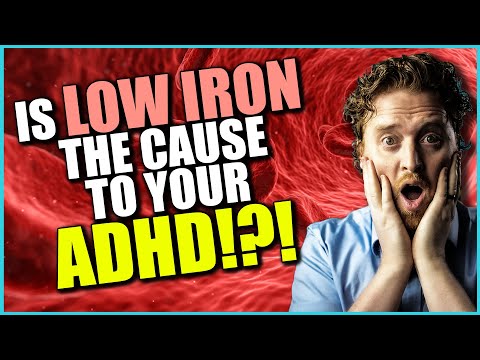The Connection Between Brain Iron Levels, ADHD Symptoms, And Aging

Table of Contents
The Role of Iron in Brain Function and Development
Iron is not merely a component of red blood cells; it's a fundamental element for optimal brain function and development. Its importance stems from its crucial role in several key neurological processes.
Iron's Importance in Neurotransmitter Production
Iron plays a vital role in the synthesis of crucial neurotransmitters, including dopamine and norepinephrine. These neurotransmitters are heavily implicated in the regulation of attention, impulse control, and executive function – areas often affected in individuals with ADHD.
- Dopamine pathways: Iron is essential for the synthesis of dopamine, a neurotransmitter crucial for reward processing, motivation, and attention. Imbalances in dopamine levels are strongly associated with ADHD symptoms.
- Norepinephrine pathways: Iron is also involved in the production of norepinephrine, which plays a crucial role in alertness, arousal, and attention. Dysregulation of norepinephrine systems can contribute to symptoms of inattention and impulsivity.
- Studies have shown a correlation between iron deficiency and altered neurotransmitter levels, suggesting a potential mechanistic link between iron status and ADHD symptomatology. Further research is needed to fully elucidate this connection.
Myelin Formation and Iron
Myelin, the fatty sheath surrounding nerve fibers, is essential for efficient nerve impulse transmission. Iron plays a critical role in myelin formation and maintenance. Impaired myelin formation, potentially linked to insufficient iron, can negatively impact cognitive function, potentially contributing to ADHD symptoms.
- Myelin sheath integrity: Iron is a key component in the enzymatic processes that build and maintain the myelin sheath. Deficiencies can lead to impaired myelination.
- Nerve conduction velocity: A compromised myelin sheath slows nerve impulse transmission, affecting cognitive speed and efficiency. This can manifest as difficulties with attention, working memory, and executive functions—hallmarks of ADHD.
- Research on the role of iron in myelin development is ongoing, highlighting the need for further studies to understand its full contribution to neurological health and ADHD.
Brain Iron Levels and ADHD Symptoms Across the Lifespan
The relationship between brain iron levels and ADHD symptoms is likely dynamic and changes across the lifespan.
ADHD in Children and Iron Deficiency
Iron deficiency anemia in children is a prevalent concern, and studies suggest a potential link between this deficiency and the presentation of ADHD symptoms. However, distinguishing between the effects of iron deficiency and ADHD itself presents a diagnostic challenge.
- Concurrent diagnosis: Iron deficiency and ADHD can share similar symptoms (e.g., fatigue, inattention), making accurate diagnosis complex. Careful assessment is essential to distinguish between the two.
- Iron supplementation: Some studies have investigated the efficacy of iron supplementation in managing ADHD symptoms in children with iron deficiency, with mixed results. More rigorous research is necessary.
- Early detection and intervention are crucial to address both iron deficiency and ADHD symptoms effectively.
ADHD in Adults and Changes in Brain Iron
As we age, brain iron levels can undergo significant changes, potentially influencing ADHD symptoms in adulthood. Aging affects iron absorption and utilization, which could contribute to altered brain iron homeostasis.
- Age-related iron dysregulation: The aging process can impact the brain's ability to regulate iron levels, potentially leading to either iron deficiency or iron overload in specific brain regions.
- Cognitive decline: Iron dysregulation may contribute to age-related cognitive decline, potentially exacerbating ADHD symptoms in older adults.
- The specific mechanisms underlying the interplay between aging, iron metabolism, and ADHD in adults remain an area of ongoing investigation.
The Impact of Aging on Brain Iron Metabolism and ADHD
Aging significantly influences brain iron metabolism, potentially contributing to cognitive decline and impacting the management of ADHD symptoms.
Age-Related Iron Accumulation and Cognitive Decline
While iron deficiency is a concern, excessive iron accumulation in specific brain regions can also be detrimental. This can contribute to neurodegeneration and cognitive impairment.
- Neurodegeneration: Excess iron can catalyze the formation of free radicals, damaging brain cells and contributing to neurodegeneration. This is particularly relevant in certain brain regions vulnerable to age-related decline.
- Iron chelation therapy: In some cases, iron chelation therapy (removing excess iron) may be considered to improve cognitive function, although its effectiveness in the context of ADHD and aging requires further study.
- Understanding the optimal iron levels for different brain regions at various stages of life is essential for developing effective interventions.
Managing ADHD Symptoms in Older Adults with Altered Iron Levels
Managing ADHD symptoms in older adults necessitates considering the complexities of age-related iron metabolism changes. Individualized treatment plans are essential.
- Personalized approach: Treatment strategies should be tailored to the specific needs of each individual, accounting for their age, iron status, and other health conditions.
- Medication management: Medication adjustments may be necessary to account for potential interactions between ADHD medications and iron levels or other age-related changes.
- Further research is crucial to refine our understanding of the interplay between age, iron levels, and ADHD management strategies.
Conclusion
The connection between brain iron levels, ADHD symptoms, and aging is intricate and requires further research. While the relationship isn't fully understood, evidence suggests that maintaining healthy iron levels throughout life may play a significant role in cognitive health and managing ADHD symptoms, particularly as we age. Understanding the impact of iron on neurotransmitter production, myelin formation, and age-related changes in brain iron metabolism is crucial for developing effective interventions. If you have concerns about ADHD symptoms, particularly as you age, or suspect iron deficiency, consult a healthcare professional to discuss appropriate testing and management strategies. Seeking further information from reputable sources like medical journals and professional organizations can help you understand the impact of brain iron on aging and ADHD and make informed decisions about your health. Remember, proactive management of your health is key to optimizing your cognitive function and well-being throughout your lifespan.

Featured Posts
-
 Antlaq Fealyat Fn Abwzby Kl Ma Thtaj Merfth 19 Nwfmbr
Apr 29, 2025
Antlaq Fealyat Fn Abwzby Kl Ma Thtaj Merfth 19 Nwfmbr
Apr 29, 2025 -
 Ray Epps Sues Fox News For Defamation Jan 6th Falsehoods At The Center Of The Case
Apr 29, 2025
Ray Epps Sues Fox News For Defamation Jan 6th Falsehoods At The Center Of The Case
Apr 29, 2025 -
 Diamond Johnson From Norfolk State To Minnesota Lynx Wnba Camp
Apr 29, 2025
Diamond Johnson From Norfolk State To Minnesota Lynx Wnba Camp
Apr 29, 2025 -
 Damon And Trump United A Case For Pete Roses Hall Of Fame Entry
Apr 29, 2025
Damon And Trump United A Case For Pete Roses Hall Of Fame Entry
Apr 29, 2025 -
 Pw C Philippines Opens New Bgc Office
Apr 29, 2025
Pw C Philippines Opens New Bgc Office
Apr 29, 2025
Latest Posts
-
 Mackenzie Mc Kees Pregnancy Announcement Baby On The Way With Khesanio Hall
May 12, 2025
Mackenzie Mc Kees Pregnancy Announcement Baby On The Way With Khesanio Hall
May 12, 2025 -
 Mueller Decisif Decryptage Du Quart De Finale Bayern Inter Milan
May 12, 2025
Mueller Decisif Decryptage Du Quart De Finale Bayern Inter Milan
May 12, 2025 -
 Farrah Abrahams Post Teen Mom Life Success Or Struggle
May 12, 2025
Farrah Abrahams Post Teen Mom Life Success Or Struggle
May 12, 2025 -
 Mackenzie Mc Kee And Khesanio Hall Expecting Pregnancy Confirmed
May 12, 2025
Mackenzie Mc Kee And Khesanio Hall Expecting Pregnancy Confirmed
May 12, 2025 -
 Bayern Inter L Heure De Mueller Analyse Du Quart De Finale De Ligue Des Champions
May 12, 2025
Bayern Inter L Heure De Mueller Analyse Du Quart De Finale De Ligue Des Champions
May 12, 2025
